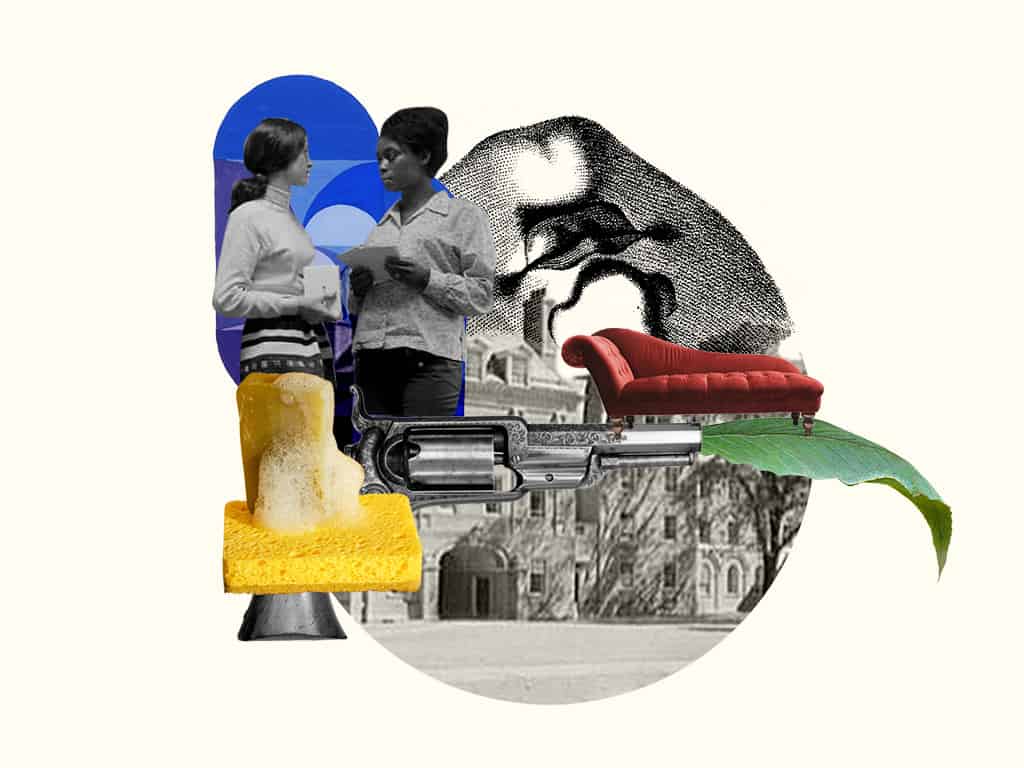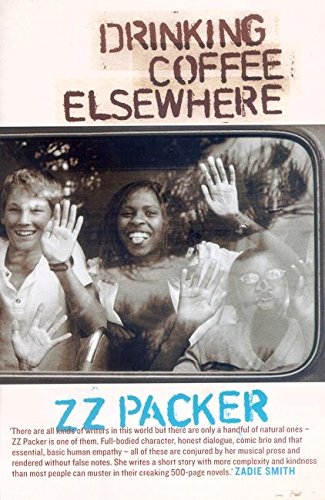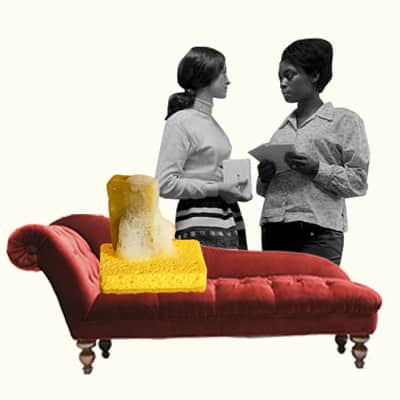She put her arm around me in mock comfort, but I pushed it off, and ignored her. She touched my shoulder again, and I turned, annoyed, but it wasn’t Heidi after all; a sepia-toned boy dressed in khakis and a crisp plaid shirt was standing behind me. He thrust a hot-pink square of paper toward me without a word, then briskly made his way toward the other end of Commons, where the crowds blossomed. Heidi leaned over and read it: “Wear Black Leather – The less, the Better.”
“It’s a gay party,’ I said, crumpling the card. “He thinks we’re fucking gay.”
ZZ Packer

Drinking Coffee Elsewhere
ZZ Packer

Packer, ZZ. Drinking Coffee Elsewhere. Riverhead Books. 2003
Drinking Coffee Elsewhere by ZZ Packer is a collection of stories about finding your voice.
Each story sits at the intersection of race, gender, and reality. We meet each character at the precise moment they find out something about themselves that irrevocably alters who they think they are.
Why This Text is Transformative?
Packer provides an unflinching perspective on the many ways there are to be a black woman, from girlhood to adulthood.
It is impossible to come away from these stories not realizing the trauma of growing up black and female in Packer’s world. The stories resonate with the complexities of race, gender, and class and the way Packer’s characters must maneuver each one with stealth and grace and sometimes violence. Packer provides an unflinching perspective on the many ways there are to be a black woman, from girlhood to adulthood.
A Focused Selection
Study Questions
“Brownies”

The following selections from the text will create a lively discussion of contemporary themes
“Brownies”
This story, told from the first person perspective of “Snot” is about a Black Brownie troop heading to a campout. When they arrive, there is a white troop also arriving, and from there things get interesting. None of the girls has really ever seen a white girl before, not in any meaningful way, not up close. When Arnette comes back from a trek to the communal bath to announce that one of the white girls called Daphne a “nigger’, everyone wants a piece of the white girls. What they discover, though, is that things aren’t always what they seem, and “Snot” must make the decision to be her own person.
Class 1 – Study Questions
1) Part of this story is about “Snot” participating in the ambush of the white girls without really having all the information. This theme resonates in particular with the (dis)information age in which we currently reside. Have you ever acted on someone else’s information without validating it for yourself? What was the outcome? Did you come to regret that decision?
2) There a couple of places where the narrator could simply refuse to follow along with Arnette’s plan. Instead, she follows along as Arnette expects. Have you ever had an opportunity to speak up and not take it? How did you feel afterward? Did someone else speak up? Did you wish after that that you had been the one to speak up?
3) Arnette seems to be a trouble maker She likes to keep things going. What’s your experience with girls (or boys) like Arnette? How did you handle girls (boys) like her when you were that age? Were you that girl (boy)?
Study Questions
“Drinking Coffee Elsewhere”

The following selections from the text will create a lively discussion of contemporary themes
“Drinking Coffee Elsewhere”
In “Drinking Coffee Elsewhere”, the title story from this collection, we meet Dina, an African American freshman woman at Yale on Orientation day. In group circle she tells the group, when asked what inanimate object she wanted to be, that she wants to be a revolver so that she can wipe out all of humanity. This does not go well, and she finds herself in regular psychiatric counseling. Her roommate moves out, and she is branded a pariah from day one. But she meets Heidi and they create a sort of friendship until Dina finds a way to put distance between them and finally ends the relationship all together.
Class 2 -Study Questions
1) A good deal of this story is about Dina feeling like an outsider in a place she’s supposed to belong. Have you ever wanted to be somewhere and then discovered you really didn’t want to be there? Was it a place you thought you should want to be? Did you leave? Was it hard to leave if you did?
1) Dina makes the comment she makes perhaps partly for effect. Have you ever done or said something purely for the impact you thought it might have on others? What was it? Did the performance backfire or were you successful?
3) Do you find it hard to make friends? Have you ever wanted to be friends with someone who resisted the opportunity? What did you do? Did you leave them alone or did you try harder?
4) Have you ever dealt with Imposter Syndrome, a situation where you get where you want to be, but feel like you don’t really deserve to be there, that somehow you’re not as qualified as everyone else? What did you do?
Building Bridges
A Recommended Pairing

A wonderful short novel by Graham Greene, Monseigneur Quixote, recasts Cervantes’ magnum opus in a way that captures much of the humor and pathos in a more modern context, as the adventures of a Roman Catholic priest and a communist mayor taking to the road together in Spain during the Franco years. The richly imagined characters and their conversations make it clear that the issues that drive Don Quixote’s idealistic quest are not raised only in books of chivalry. How do we live with a commitment to the ideals of a religious faith or a political ideology which, though noble, may not fit easily with and may have unfortunate consequences in the unforgiving world in which we find ourselves? What difference does friendship make in our lives?
Supplemental Resources

Don Quixote and the Windmills, 1945 - Salvador Dali - WikiArt.org
Don Quixote has been an inspiration for many visual artists. Spanish surrealist Salvador Dali returned to the novel multiple times throughout his long career, creating sketches, paintings, and sculptures of Don Quixote and Sancho, depicting important episodes in the book. A pairing of an episode with one of Dali’s works can lead to a stimulating discussion.
What details do students notice? What do his artistic choices suggest about his interpretation of the characters? To the extent that students are familiar with the story of Don Quixote, it is likely to be as it is filtered through the musical The Man of La Mancha. The musical has its own merits, and is framed by the interesting device of placing Cervantes on stage as a narrator, but of course it is impossible for it to capture much of the complexity of the book – and it alters the ending dramatically. Students may find it interesting to compare the two endings.
Text Mapping
Discipline Mapping
English/Composition Studies
Humanities
Area Studies
Page Contributor



